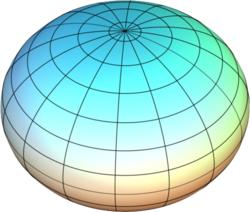Reference ellipsoid
A reference ellipsoid is an ellipsoid which is used as a frame of reference for geodetic calculations. It is a figure like the shape of the Earth. It is easier to work with than the geoid, which is another shape like that of the Earth.

It is relatively easy to describe the reference ellipsoid using mathematical formulae. Describing the geoid is much more complex, as it results from precise measurements. The first such models were spheres, used since Ancient Greece. In the 17th century, there were doubts that the earth was a sphere. In 1688, Isaac Newton solved a controversy with Giovanni Domenico Cassini by demonstrating mathematically that the rotation of the earth would lead to a flattening around the area of the poles, and not at the equator.
In practice this was shown by Pierre Bouguer and Alexis-Claude Clairaut half a century later. The two had done an expedition to Peru and Lapland (1735-1741). Their measurement of the meridian arc lead to the definition of the metre. This was the ten-millionth part of the idealized distance between the pole and the equator, 1791. Because of different errors in measurement, it turned out to be 0.022% too short, and was redefined twice, in 1793, and 1799. The value of 1799 is still the official definition but it is about 0.197‰ too short.
In 1983, the metre was redefined as the distance, light travels in a certain amount of time, in a vacuum.